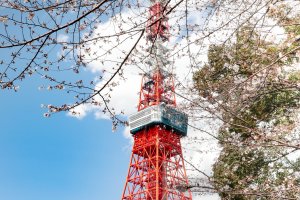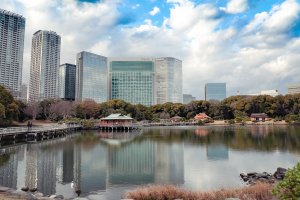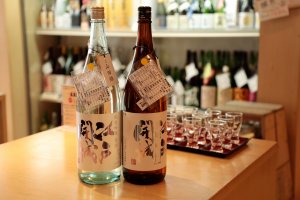Though the word Shiba might bring to mind images of fluffy Japanese pups, I'm talking about the Shiba district in central Tokyo. Whilst at first glance you might be overwhelmed by corporate skyscrapers, Shiba is home to some of the city’s most iconic architecture, and an area of great historical importance. This neighbourhood is a popular tourist destination and ideal for experiencing the juxtaposition of old and new Japan.
I’ve put together my top 5 spots across Shiba district, as a walking guide you can use this to take you from central Tokyo out to the Bay, or you can just meander through the city as you please.
1. Tokyo Tower

Tokyo Tower has been an iconic feature of Tokyo’s landscape since its erection in 1958. The bright orange tower defines the Shiba area and is the perfect spot to gaze out over the city. The main deck at 150 meters offers panoramic views and is accessible via lift, or for those ready to feel the burn, a 600-step staircase. There is a secondary deck at 250 meters which offers a truly stunning birds-eye view of Tokyo and even Mount Fuji on a clear day. Tokyo Tower’s observation deck is second in height to Skytree but without the hours of queuing and has the bonus of an aquarium, several cafes and One Piece Tower; an anime amusement park at its base. The tower synonymous with Tokyo's skyline is a must-see!
2. Zojoji Temple

Zojoji Temple is one of the most scenic temples in Tokyo, especially in the spring where the sakura-filled garden contrasts beautifully with the iconic Tokyo Tower. Zojoji, the first Nembutsu Dojo (training hall) in Kanto, was founded in 1393 by the Buddhist priest Yuyo Shoso. Zojoji became the family temple of the Tokugawa Shoguns in the Edo period, and was once home to more than 3000 Buddhist priests.
The temple was destroyed in the Second World War, though the Main Gate has remained standing since 1622. Most of the temple has since been reconstructed, home to the Mausoleum of the Tokugawa Shoguns, the Treasures Gallery and the sombre Unborn Children Garden, Zojoji is well worth a visit. I recommend timing your visit in the early morning or at dusk when the enormous 1673 Daibonsho bell is tolled to purify the 180 earthy passions (bonno) that lead us astray, especially if you're headed to our next spot to indulge in a glass of Japan's finest brew.
3. Meishu Center

Meishu Center is a tasting bar which offers an accessible introduction into Japanese sake. The small shop stocks sake from 47 domestic distilleries, in addition to several Japanese beers and plum wines. As a sake novice, it can be difficult to know where to start in a store offering more than 150 bottles. But here at Meishu Center, the display cabinets have explanations of the rice purity, fortification and the Sake Meter Value (SMV) which details the flavour profiles from sweet and smooth to rich and dry. Each bottle has a corresponding tag describing its brand, prefectural origin, rice strain, quality and SMV.
The shop offers a 100-yen discount when you try three 60 ml glasses of sake, making it ideal for finding your favourite flavour. They have English language guides describing how to choose your sake and a glossary of terms. Fortunately the Meishu Center in Shiba has an English speaking staff member working Monday and Friday evenings to guide us novices through the process. The staff are expert at choosing a sake to suit each customer and are at ease introducing beginners to this exciting gastronomic experience.
I chose to sample a selection of Tokyo brewed sake, my favourite being from the Tokyo Minato Jouzo brewery located just 30 minutes away in Shinbashi. Once you’ve tracked down your ultimate sake and sampled a few smoked cheeses, why not bring home a bottle to savour the flavour of Japan?
4. 'Seaside Top' Observatory at the World Trade Center Building

The Seaside Top observatory at the Tokyo World Trade Center is one of the most overlooked hidden gems in the city. The 152m tall skyscraper has recently been renovated and offers 360-degree views of the Tokyo. The building is situated perfectly to afford both city and bay side views. This observatory is a steal at just 620 yen and with its 200-meter circumference is rarely crowded. It is a rare treat to have such an abundance of seating; this observatory has sofas, couple’s seats and individual tables giving you the perfect opportunity to sit back, relax and enjoy watching the city beneath.
If you find yourself having whiled away the afternoon and in need of some refreshment, the World Trade Center Building is also home to Restaurant Rainbow, which offers panoramic views from the 39th floor and specialises in French cuisine. As the sun goes down, I recommend trying out Bar 39, which offers private booths. Outside each booth is a caddy filled with the city workers reserved bottles, you'll be amazed not only by the views, but also by the impressive drinks cabinet local salary-men have stocked.
5. Hamarikyu Garden

Hamarikyu is the family garden of the Tokugawa Shogun and is a designated cultural heritage site. This garden features a seawater pond which changes with the tide of Tokyo Bay, three tea houses, a 300-year-old pine and a Japanese cypress bridge. The garden has undergone reconstruction and the elegant architectural features perfectly replicate the original historical designs. The original Nakajima tea house, built in 1707, was considered as one of the most splendid of its time. Now reconstructed, guests are invited to enjoy green tea and traditional sweets overlooking the pond for just 510 yen.
The wooden Otsutai bridge offers a typically Japanese view, contrasting the elegant Tsubame tea house against the backdrop of enormous skyscrapers. Be sure to check out the Hamarikyu Garden's flower calendar to enjoy the blossom of the season from sweet spring plum blossoms and vibrant fields of rape (canola) to the dramatic hues of the autumnal Maple and Ginko trees. After touring the traditional gardens, you can use the waterbus stop to hop on the futuristic boat and glide down the Sumida river, stopping off at some of Tokyo’s most famous tourist spots.


































